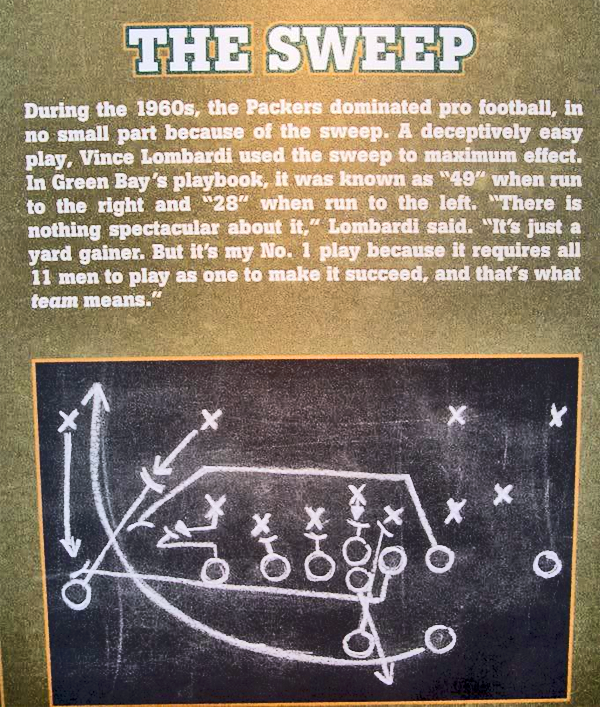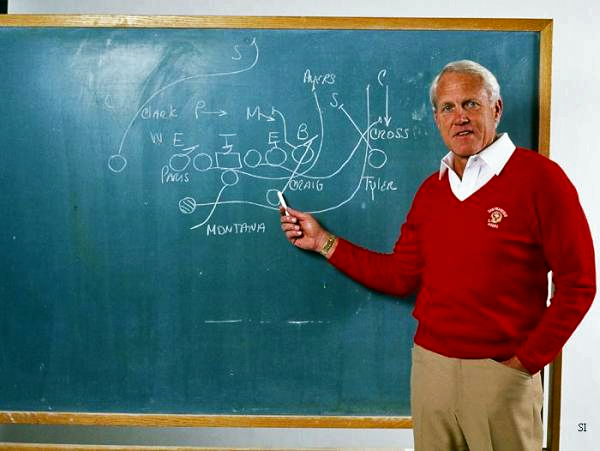Power Sweep of the Green Bay Packers

The Green Bay Packers of the 1960s under Vince Lombardi lived off this rather simplistic running play, executing it to such perfection that they dominated foes from all over the NFL. It separated Lombardi from the pack of his peers at the coaching level as he would rack up a record of 65-16-4 (76.5 win percentage) from 1961 through 1966. Lombardi would not only win 3 NFL Championships preceding the era of the Super Bowl but immediately won the first two Super Bowls back to back. Aided by talent such as Paul Hornung and Jim Taylor in the backfield with Jerry Kramer, Fuzzy Thurston, and Forrest Gregg at the guard spots it was little wonder that the Packers dominated their opponents in such indelible fashion.
This play was such an offensive staple of the Packers and the dominant, downhill running game of the time period that later coaches such as legendary offensive genius Bill Walsh also imported the play into their own playbooks. Walsh would utilize it primarily with talent such as RB Roger Craig in the backfield during his 49ers tenure in the 1980s.

The Actual Play
The play was predominantly run out of a two back Pro Set formation with a FB lined up on the right side and a HB lined up on the left side. The beauty of this formation was that the Packer Sweep could be called to attack either side of the defense with either backfield runner meaning that defenses couldn’t key on either back and the play could be audibled to take advantage of a weak side as seen with the Bill Walsh diagram above.
Blocking is emphasized as the outside receivers take off and are in charge of sealing off the deep safeties down the field. The center primarily takes on the defensive tackle if he’s lined up at 0 technique head up on him. If the defensive tackle is lined up at a 3 technique and is too fast for the center to reach, the center will make a call and take out the middle linebacker while the playside tackle picks up the defensive tackle inside. Depending on the formation’s alignment, the slot receiver or tight end seals off the nickel cornerback or strongside linebacker. The slot receiver or tight end is primarily going to dictate the alley for the running back based on how he blocks his defender, whether it’s inside (allowing for a run outside) or outside (allowing for a run inside). This where the infamous “alley” phrase comes from Lombardi in regards to the Power Sweep. The fullback’s job is to seal the edge defender, usually a defensive end, unless the offensive tackle picks him up in which case the fullback continues ahead and seals off the middle linebacker coming down the line.
In a lot of ways, this is a prototype zone block and zone run play in general in which the tackle/fullback key the edge defender then one shifts to the second level to take out the linebacker. The playside guard pulls out and primarily blocks the cornerback who was eschewed by the outside receiver so the receiver can pick up the safety downfield. The backside guard pulls towards the playside and turns up field at the first hole he sees, sealing off on the inside as well and acting much like a lead fullback does on staple running plays such as inside dives or stretch run plays. The backside tackle pulls as well and seals off the weakside defensive tackle or weakside defensive end. If either pursues away downfield, the backside tackle continues pulling and seals inside off the first hole that they see.
Nowadays with the influx of the spread offense, this can still be a very interesting play to pull off as a team can line up a tight end and rotate them into the backfield to use as an inline blocker. By lining up the tight end as an h-back just behind the offensive tackle, the exact same blocking assignments can be played out as Lombardi diagrams it in the opening video while still giving those teams a three receiver look to let them stay in a spread look if running a hurry up no huddle tempo too.
The Transition to Modern Day Football
Coaches continue to run the Packer Sweep, merely dressing it up in a variety of different formations and under different nomencloture such as the Buck Sweep or in the NFL, Truck Sweep. Below is a rather simplistic showing of how even with a four receiver formation, how a variant on the classic Packers Power Sweep can still be run in today’s college and NFL. In the beneath image, only the backside cornerback and backside linebacker are unaccounted for blocking wise. The pulling backside tackle can be given the option of taking out the linebacker as well and hoping the defensive end gets taken out in the wash of bodies. The backside cornerback has a lot of field to cover before getting involved and can largely remain unblocked (or picked up if another man is taken out). Backside guard pulls and takes out the middle linebacker while the receivers seal the deep safeties and slot receivers seal their defensive backs.


